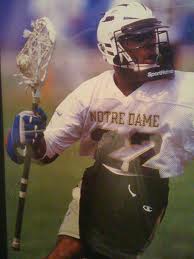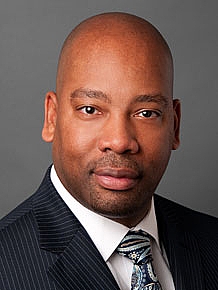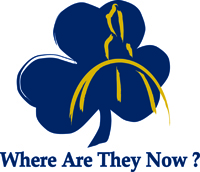Where Are They Now? Tony Suber
The paths to Our Lady’s University are as varied as the men and women who find their way there. Some of us made it there via family legacy; some of us as the result of a lifelong dream,and others because of the role models who surround us. Tony Suber’s path to Notre Dame followed that third road — he saw men around him who he strived to become and they were the guiding force which drew him to Notre Dame. How does a minority student from Pittsburgh, Pennsylvania get offered a chance to play Division I lacrosse at Notre Dame and later in life return to become a Development Officer for the University’s high networth benefactors? Walk Tony Suber’s journey with me.
Q: As a kid growing up in Pittsburgh, at what point did you become interested in attending Notre Dame?
 A: “I became interested in Notre Dame when I was a freshman in high school at Sewickley Academy. Ray Zellars is a family relative of mine and he was being recruited to play football for Notre Dame when I was a freshman in high school. This gave me the chance to watch his recruiting process and to speak with him about the process as well as the difference between all of the schools which were recruiting him.”
A: “I became interested in Notre Dame when I was a freshman in high school at Sewickley Academy. Ray Zellars is a family relative of mine and he was being recruited to play football for Notre Dame when I was a freshman in high school. This gave me the chance to watch his recruiting process and to speak with him about the process as well as the difference between all of the schools which were recruiting him.”
“We already had a strong spiritual background in our family and with me attending Sewickley Academy education was obviously very,very important. Going to a top-20 college was not only a serious consideration but it was almost demanded as far as expectations were because of thecaliber of the Academy. Notre Dame presented itself as the kind of school that presentedboth fantastic academics and spiritually-based education — and it didn’t hurt that the ND network in the city of Pittsburgh was very strong, very vocal, and very palpable to some degree. I remember growing up seeing Notre Damemen in my community and around the city of Pittsburgh who I would say very proudly wore their Notre Dame colors – to them those colors stood for much greater accomplishments and values.They represented ND very well and did it in such a distinguished manner compared to other men and other alma maters. It really made Notre Dame stand out. The type of men that Notre Dame men were, I gravitated towards those kinds of men. Unlike a lot of kids and applicants I did not grow up wanting to go to Notre Dame, it became a choice because of maturity. The icing was when Coach Kevin Corrigan recruited me to play lacrosse there.”
Q: How did you become interested in playing lacrosse? How old were you when you started playing lacrosse? Did you play any other sports?
A: “I started playing lacrosse at the age of 14. That was the year I left a public city school and attended Sewickley Academy. My first semester on campus I played soccer in the fall and during the next sporting season I played basketball. In the spring all of the kids that played with me on those two teams played lacrosse. The choices for spring sports were lacrosse, baseball or cross country and since my closest friends were all going to play lacrosse I chose that sport as well. I had never played lacrosse before but I was a natural athlete and was excited and willing to learn and play a new sport.”
Q: What was it like being a non-football athlete at Notre Dame?
A: “I think that in terms of being a Division I athlete, the differences were minimal from a student-athlete perspective. The biggest difference is that there was no media microscope for our lacrosse players, even for the best lacrosse players, like there always is for the football players. I was never concerned that my life off the field was ever going to be scrutinized or put under a microscope like a lot of my peers who played football. Not to say that I took advantage of that in a negative way, but there was a palpable difference that I experienced.”
“What I experienced then and even now is being accused of being a football player at Notre Dame. Still today I get the accusation or assumption that I played football at Notre Dame. Maybe it’s because of my size and stature. It’s not uncomfortable, but it’s something that I have to clarify because it’s usually the second or third question I get asked.”
Q: Can you talk about the enormous growth of the sport of lacrosse both at Notre Dame and nationwide?
A: “During my high school years (1989-1993), because the sport was so rare in terms of the number of schools in the city of Pittsburgh that had lacrosse programs, we were forced to travel to six different states during the course of one schedule year to find good competition. We traveled as far west as Michigan, as far south as North Carolina and as far east as the Baltimore/Washington DC area. We played just about anyone who was willing to play us no matter where they were located. In Pittsburgh during the late 80s early 90s there were nine competitive high school lacrosse teams. Today it is recognized as a state sport with a state championship game.”
“If you look at the same time frame at Notre Dame, the explosion of the sport of lacrosse really lends itself to why I was recruited. I did not grow up in a lacrosse hot bed (which would be Baltimore and Long Island); instead I grew up in an area where no one knew we actually played lacrosse. But that was my reality and because of the explosion of the sport I had the opportunity to compete at such a high level at Notre Dame. I was not playing at the level of a Baltimore or Long Island kid, but I was very well prepared by the time I got to Notre Dame thanks to all of the traveling I did.”
“Today the exponential growth of lacrosse just continues.”In 2012 there were nearly 300 men’s lacrosse teams at NCAA schools (http://www.laxpower.com/common/participation12.php) and over 350 women’s lacrosse team (ranging from Division I to Division III). At the high school level the participation level has grown 149% just since 2006 (http://www.laxpower.com/common/ParticipationRates2012.php). Staggering participation numbers that just continue to grow.
Q: As a former fundraiser for Notre Dame’s development office, can you talk about the power of the Notre Dame brand and the ND alumni network?
A:“I don’t know that I can add anything to anyone’s assumptions, but I can say the following. No matter where you go in the world someone loves you, or someone hates you, because of your affiliation with Notre Dame. What I always cared about most is that they cared enough to love us or hate us. The day we become irrelevant to their care we’ve got a problem. There are tons of stories that I could share relative to my time in the Notre Dame Development Department, but each one of those experiences I hold near, dear and sacred. But in terms of service to the University I don’t think I could have picked a better place to work than for the Development Department at ND, to pay back the University for what I believe is a fantastic legacy for me and my family.”
Q: Where has your career taken you since your time at Notre Dame?
A:“Right out of college I worked in the marketing/communications field for United Media Group and DesignSpin, followed by working in the insurance industry as a Sales Manager for Liberty Mutual. Then I went into fundraising and institutional advancement at Notre Dame in their Development Department and it was there that I truly found my passion. And that passion was, or rather is, helping individuals with exploring and figuring out their philanthropy; and on the flip side of that, helping non-profits figure out and create strategies around developing high network relationships.”
“After leaving the Notre Dame Development Department what I found to be true for most non-profits is that high level net worth development is a very complex role and I was lucky that ND gave me the opportunity to begin my career in development at that level. It (high level net worth development) is a very rare commodity in the philanthropic world. It’s all about who you know and to some degree who knows you.”
Q: What was your biggest challenge as a Notre Dame student-athlete? How did Notre Dame prepare you for life after college?
 A: “My biggest challenge as a student-athlete at Notre Dame was time management. As a Division I student-athlete you can’t imagine how good you’ve got to be at managing all of the new responsibilities that you have coming from a high school environment. In high school you can rely on your family, parents, siblings and to some degree your teachers, administrators and coaches. In college you can rely on them to some extent, but at the end of the day you are becoming an adult and you are expected to manage your life accordingly. The last thing that any of those people who love you with all their heart want to do is hold your hand while you make that transformation because if they do they are actually impeding your development.”
A: “My biggest challenge as a student-athlete at Notre Dame was time management. As a Division I student-athlete you can’t imagine how good you’ve got to be at managing all of the new responsibilities that you have coming from a high school environment. In high school you can rely on your family, parents, siblings and to some degree your teachers, administrators and coaches. In college you can rely on them to some extent, but at the end of the day you are becoming an adult and you are expected to manage your life accordingly. The last thing that any of those people who love you with all their heart want to do is hold your hand while you make that transformation because if they do they are actually impeding your development.”
“Interestingly enough, what was not a challenge was adapting to being an African American student at Notre Dame. I was fortunate that I had my Sewickley Academy experience to in some ways over prepare me for what occurred at Notre Dame. I had six years to get used to that prior to even getting to ND and in some ways I was over prepared because of the sheer amount of wealth that was present at the academy which was staggering. It was a great background to have to prepare me for the transition to Notre Dame.”
Q: What advice would you give current student athletes?
A: “Find a way to be a student. And what I mean by that is find opportunities that you havea passion for or that will help you find a passion. Develop who you are in this young adult to adult transition phase. Find friends who are not your teammates and begin to develop relationships with the University. Make connections outside of your sport. Far too many (Notre Dame) athletes spend their free time in their dorm rooms resting and not taking advantage of what I believe is one of the greatest crucibles of networking in the country. If you separate yourself from the rest of your peers then you have no one else to blame but yourself. Find ways to be involved.”
Tony’s thoughts …
“I have three thoughts and I’m trying to decide which one is most important …”
“Prior to Andre Jones’ passing he and I were working on some ideas centered around developing a holistic Notre Dame experience for student-athletes, football players in particular. It is one of the things I would love to see the University embrace, to wrap its arms around at a much deeper level thanwhat they are already doing. They are doing some of this but it needs to be at a much deeper level and more hands on.”
“The University needs to find ways to introduce current student-athletes and football players to the Notre Dame business community. I know that the topic is a touchy issue with compliance, but we shouldn’t avoid it just because it’s a touchy subject. We should proactively find ways to get our football players engaged with our Notre Dame network. Very few college football players leave the University and live out their dream of becoming a NFL player. What happens to the other 90 percent? There are far too many former football players that because of their own doing, by not engaging themselves in the Notre Dame network, take far too long to get tied in as a young business professional. I still have conversations with former football players from the 80s that share with me that they don’t feel very connected to the Notre Dame business community at all.”
“I think we can do something about it.”
“There is an easier way to do it. It shouldn’t be this difficult.”
“Stanford does a fantastic job at this — Andre and I talked about benchmarking what we do against them. We talk about the ND network and the ND family in very glowing terms but that reality is not true for every Notre Dame alumni and it should be. Until it is true for every alumnus it’s only somewhat true.”
Tony currently lives in Atlanta, Georgia with his wife Jamila, and their three children; Jancy, Jayla and AJ. You can find more about Tony on his web site www.tonysuber.wordpress.com/about
I’d like to give a big thank you to Tony for stopping by the blog. It was an absolute pleasure to walk through his journey with him. Stay tuned for many more great stories in the “Where are they now?” series!
***
Want to hang out with Notre Dame greats Tony Rice, Pat Terrell and John Foley? Join me and the guys for an “Echoes From the End Zone: The Men We Became“ book signing and Q&A session at Racine Plumbing in Lincoln Park (Chicago) THIS Saturday, from 4:30 pm – 6:30 pm. For more information click here.
Cheers!
- Breaking Discoveries in CTE Research? - March 12, 2018
- A Football Player’s Lucky Charm? - February 22, 2018
- Part II: From Football to Coffee Beans? - January 31, 2018
